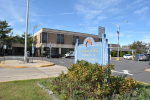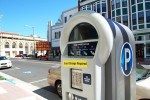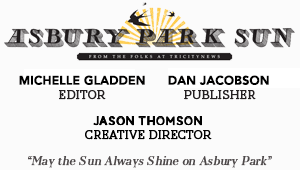Still no solution for Savoy situation
Planning board to recommend city conduct parking study
Developer Carter Sackman and his attorney Andrew Karas brought the Kinmonth Project before the planning board once more last night, this time with testimony from parking expert George Jacquemart. After hearing from Jacquemart, the board recommended the city complete an independent parking study.
Sackman hopes to restore the Kinmonth Building [pictured at right], on Mattison Avenue, which includes the 100-year-old, 800-seat Savoy Theatre on the ground floor. The Savoy closed in the 1970s. He plans to create 64 studio apartments in the upper floors, but says the city-required parking for those units — 96 spaces or a $1 million payment to the city parking fund — is not economically feasible at this time.
After hearing Jacquemart’s testimony and allowing public questions and comments, the board attorney drafted a recommendation to send to the city council. If approved at the next planning board meeting on July 23, the board’s recommendation will call for the city to conduct its own independent analysis of the proposed structure’s parking needs. The board also will recommend the existing street parking in front of the site not be included in satisfying the residential component of the project.
Before discussing the recommendation, the board heard Jacquemart’s testimony. Jacquemart conducted a parking study over the course of about a month, he said. He examined the Savoy Theatre site and compared the planned residential component to similar projects throughout the country.
He also projected characteristics of the Savoy Theatre apartments. The average size of a studio will be 251 square feet, he said. The developer hopes to attract young workers who have jobs in New York or commute using mass transit.
The site is one block from NJTransit train and bus service, and within walking distance of retail, restaurants, employment and recreation, he said. The building’s amenities include a bicycle storage room, and he estimated the expected rent at $700 per month, although Sackman has said rent for the four larger studios would be closer to $1,000.
Jacquemart assessed the parking situations at four sites:
At the Hudson Park development on the Yonkers, N.Y., waterfront, he found .88 cars per one-bedroom apartment. The apartments there are 665 to 1,270 square feet.
At 550 Cookman Ave., the 31 total apartments average 1,200 square feet, Jacquemart said. Of the 15 leased apartments, five tenants lease one space each, he found.
At 202 Island in San Diego, Calif., he found .46 parking spaces per apartment. That structure is a “low-cost SRO [single-room occupancy] hotel,” Jacquemart said.
And at Alma Place in Palo Alto, Calif., the rate is .68 spaces per apartment, totalling 72 spaces in a 106-unit SRO hotel.
Jacquemart also proposed some transportation demand management strategies Sackman could employ, including the bicycle storage room; a car share system like ZipCar; or developer-provided shared bicycles.
Based on the survey, Jacquemart concluded the site should have a maximum parking ratio of 0.5 spaces per unit, with credit for on-street parking, meaning the spaces on the street in front of the Savoy should contribute to the parking requirement. The city requires 1.5 spaces per unit.
“I see this as a workforce housing project,” he said. “Many cities are trying to develop these types of projects. They also look at them as starter units for young people who want to live on their own and have a job in this environment.”
But members of the planning board and the public were not convinced that only half of the Kinmouth residents would use parking spaces.
“Some of these vehicles may be parking on the street,” city redevelopment and planning director Don Sammet said of the sites Jacquemart surveyed. “I think you just counted what was on-site in each parking lot.”
Also, the developments surveyed are all located in larger cities with more employment opportunities than Asbury Park, although Palo Alto is similar, Sammet said.
“I don’t think this is similar to Asbury Park’s needs at all,” board member Seresa Grillo said of the survey. “Saying someone may move here with the intention of not having a car to live in Asbury Park … isn’t a fair argument.”
Board member Robert Feinstein agreed.
“It takes two hours to get to New York on the train,” he said. “I don’t know anyone who uses the train to get anywhere … I appreciate the work but it’s not current or accurate to Asbury’s situation.”
Sackman charges other downtown tenants $100 per month for parking in the spaces he provides at various surface lots in town.
“A person living in a $700 studio couldn’t afford to pay $100 a month” for a spot, board chair Herb Fehrenbach said, “when the city provides a $30 spot for the year.”
The city averages a profit of $150 or more per month per metered space, Sackman said.
“They have the opportunity of metering it and opening it up,” he said. “I’m always looking for a solution and I’ve already looked into a variety of different options. I have three lots and a variety of spaces. I could open up all my spaces and provide meters like the city does, get an income off of commercial activities.”
Former city councilman James Keady spoke about the sites Jacquemart included in his survey during public comment.
The population of Yonkers, N.Y., is 195,000, Keady said, and it’s a 30-minute train ride from Yonkers to Grand Central Station in New York City. The population in San Diego is 1.3 million, and the population in Palo Alto is 64,000, he said. The population in Asbury Park is 16,500.
“There’s more than adequate employment for them to tap into [in Yonkers, San Diego and Palo Alto] that wouldn’t necessitate them having a car,” he said.
He also talked about the actual space taken up by parking in the city. If 40 of the Kinmouth Building’s occupants parked on the street, that would encompass “all the diagonal parking from Main Street to Press Plaza on Mattison Avenue,” Keady said. And if the theatre sold out a show with half of the attendees arriving in the city by car, with two people in each car, 200 spaces would be required. That would encompass all the spots on Main Street from Springwood Avenue to Sunset Avenue, Keady said.
Board members Fehrenbach and Feinstein both felt one space per unit would be preferable to .5 spaces per unit, and board member John Loffredo suggested the city do its own analysis.
“The board recommends the city does its own independent analysis of parking needs for this project independently of the applicant and it be addressed on that level,” board attorney Jack Serpico said, “with no street parking permitted for the residential component … The only way we’re going to get an independent analysis is if the city does its own.”
Board members then voted unanimously to have Serpico draft the recommendation. They can vote to approve it and send it to the council at the next planning board meeting.













